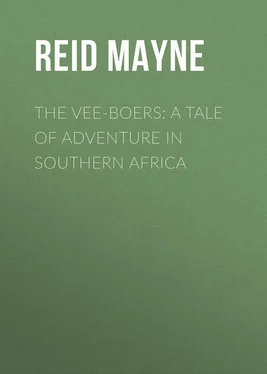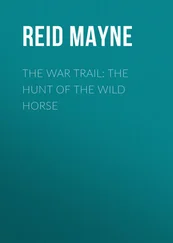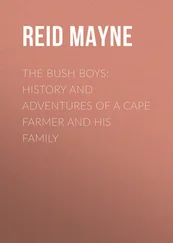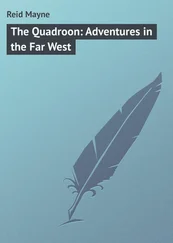Mayne Reid - The Vee-Boers - A Tale of Adventure in Southern Africa
Здесь есть возможность читать онлайн «Mayne Reid - The Vee-Boers - A Tale of Adventure in Southern Africa» — ознакомительный отрывок электронной книги совершенно бесплатно, а после прочтения отрывка купить полную версию. В некоторых случаях можно слушать аудио, скачать через торрент в формате fb2 и присутствует краткое содержание. Жанр: foreign_prose, foreign_children, на английском языке. Описание произведения, (предисловие) а так же отзывы посетителей доступны на портале библиотеки ЛибКат.
- Название:The Vee-Boers: A Tale of Adventure in Southern Africa
- Автор:
- Жанр:
- Год:неизвестен
- ISBN:нет данных
- Рейтинг книги:4 / 5. Голосов: 1
-
Избранное:Добавить в избранное
- Отзывы:
-
Ваша оценка:
- 80
- 1
- 2
- 3
- 4
- 5
The Vee-Boers: A Tale of Adventure in Southern Africa: краткое содержание, описание и аннотация
Предлагаем к чтению аннотацию, описание, краткое содержание или предисловие (зависит от того, что написал сам автор книги «The Vee-Boers: A Tale of Adventure in Southern Africa»). Если вы не нашли необходимую информацию о книге — напишите в комментариях, мы постараемся отыскать её.
The Vee-Boers: A Tale of Adventure in Southern Africa — читать онлайн ознакомительный отрывок
Ниже представлен текст книги, разбитый по страницам. Система сохранения места последней прочитанной страницы, позволяет с удобством читать онлайн бесплатно книгу «The Vee-Boers: A Tale of Adventure in Southern Africa», без необходимости каждый раз заново искать на чём Вы остановились. Поставьте закладку, и сможете в любой момент перейти на страницу, на которой закончили чтение.
Интервал:
Закладка:
Mayne Reid
The Vee-Boers: A Tale of Adventure in Southern Africa
Chapter One.
On the Karoo
A vast plain, seemingly bounded but by the horizon; treeless, save where a solitary cameel-doorn 1 1 The “cameel-doorn,” literally, camel-thorn, is a species of acacia, whose tender shoots and leaves are the favourite food of the cameleopard, or giraffe. It is a common and characteristic tree in most districts of southern Africa, having pinnate leaves, and, like most of the acacia tribe, bright yellow blossoms.
spreads its feathered leaves, or a clump of arborescent aloes, mingled with rigid-stemmed euphorbias, breaks the continuity of its outline. These types of desert vegetation but proclaim its sterility, which is further evinced by tufts of whiteish withered grass, growing thinly between them.
Over it three waggons are moving; immense vehicles with bodies above four yards in length, surrounded by an arching of bamboo canes covered with canvas. To each is attached eight pairs of long-horned oxen, with a driver seated on the box, who flourishes a whip, in length like a fishing-rod; another on foot alongside, wielding the terrible jambok , while at the head of the extended team marches the “foreloper,” reim in hand, guiding the oxen along the track.
Half a score horsemen ride here and there upon the flanks, with three others in advance; and bringing up the rear is a drove of milch cows – some with calves at the foot – and a flock of fat-tailed sheep, their tails full fifty pounds in weight, and trailing on the ground.
The cows and sheep are in charge of ten or a dozen dark-skinned herdsmen, most of them all but naked; while a like number of large wolfish-looking dogs completes the list of living things visible outside the waggons. But, were the end curtains raised, under their tilts would be seen women with children – of both sexes and all ages – in each the members of a single family, its male head excepted.
Of the last there are three, corresponding to the number of the waggons, of which they are the respective proprietors – the three men riding in advance. Their names, Jan Van Dorn, Hans Blom, and Klaas Rynwald. All Dutch names, and Dutch are they who bear them, at least by descent, for the scene is Southern Africa, and they are Boers .
Not of the ordinary class, though, as may be told by their large accompaniment of unattached cattle and sheep – over a hundred of the former, and three times as many of the latter. These, with other signs well-known to South Africans, proclaim them to be Vee-Boers 2 2 “Vee-boers” are distinguished from other Boers by their special employment being the grazing and raising of cattle. To this they devote themselves exclusively, as the stockmen of Australia, and the ranchmen of Western America. They have no fixed habitation, flitting about from place to place with their flocks wherever the pasture tempts them, and making house and home of their huge trek-waggons, just as the “cheap jacks” of England. They have tents also, and sometimes erect rude huts.
.
They are far away from any settlement of civilised or white men, the nearest being their own frontier town, Zoutpansberg, in the Transvaal, from which they are distant full three hundred miles northward. Nor are they in Transvaalian territory, but that of the Tebelé, beyond the Limpopo river, and journeying on north.
Why they are there calls for explanation, and a word will suffice. The world has of late heard much of the Transvaal Republic and its brave people; how distasteful to them was annexation to the English Government; indeed, so repugnant, that many plucked up the rooftrees they had but lately planted, and were off again, scarce thinking or caring whither, so long as they got beyond the reach of British rule.
It is on record – a painful one – that many of those political fugitives passed through hardships scarce conceivable, and not a few perished by the way – miserably perished, the victims of fatigue, hunger, and thirst. And it is of just such a party we purpose giving account of, their journeyings, adventures, and dangers, by flood and by field.
The time was just after the annexation, and our Vee-Boers, as introduced to the reader, were weeks away from their abandoned homes in the Transvaal.
That they had permission to enter the territory of the Tebelé, might be taken for granted, otherwise they would have been on dangerous ground. For its powerful and despotic chief was not the man to allow intrusion into his dominions, even by peaceful travellers.
But they had his leave, backed by invitation, not only to pass through, but make permanent home in them, if they wished. Jan Van Dorn, the “ baas ” 3 3 “Baas,” master. It is synonymous with the “boss” of the Southern United States, which, no doubt, was carried thither by the slave negroes who had had dealings with the Dutch of South Africa.
of the migrating party, an old jäger , had, in bygone days, hunted all over the Tebelé country, smoked the pipe of peace with Moselekatse himself, and so established a friendship still existing. In one of his expeditions he had discovered a magnificent grazing country – a very paradise for the Vee-Boer – and it was for this they were now making.
They were journeying by night, or rather early morning, before daybreak. It was not their habit to lie late; but just then they had more than one reason for being up betimes and moving. It was in the Torrid Zone, where travelling by day is oft a very torture, especially over a plain such as that they were crossing.
They had entered upon a track of karoo 4 4 The “karoos” of Southern Africa may be compared with our moorlands, only more extended in area, and with a different sort of vegetation. Heaths of many beautiful species are among their characteristic plants, as all may know who take a pride in the keeping of hothouses.
, which they knew to extend for more than 100 miles; treeless, shadeless, and without water, save here and there in pools, or natural cisterns, at long distances apart. Besides, no rain had fallen on it for months, and like as not the water reservoirs would all be dried up. Not strange, then, their travelling by night, as by day; for it was life or death to them to get across the karoo.
Luckily they were favoured by moonlight, with stars in a clear, unclouded sky, which insured them against straying from the practicable route. And as their guide, a Hottentot, by name Smutz knew every inch of it, they had confidence in his piloting.
So on they moved, noiselessly, save when now and then crack of whip, the sharp snap of a jambok (Note 5), or the ejaculations of the men wielding this formidable instrument of animal torture, disturbed the stillness of the night. More rarely was it broken by the rumble of wheels, these for the most part being fellies deep in soft, yielding sand.
Chapter Two.
A Weird Spectacle
Going at a slow crawl in profound silence, the huge vehicles, with their dark bodies and white tilts, the long serried line of yoked oxen extended in advance of them, would have presented a strange mystifying spectacle to one not knowing what it was. Weird and ghostlike under the silvery light of the moon, a native of the country, where such had never been seen before, viewing it from a distance, might have imagined it some monster of a world unknown.
But before morning came, the travellers were themselves witnesses of a spectacle common enough in that same district, yet, in seeming, quite as strange and mysterious as that of the waggon-train.
Proceeding in the opposite direction, and at no great distance off, appeared a number of dark forms, one following the other in single file. Immense creatures they were; each nearly as large as any of the waggons, but, unlike these, living and breathing. For they were elephants – a troop on the march – nigh threescore in number, their line extending for hundreds and hundreds of yards across the karoo. They were passing on silent as spectres, the tread of the ponderous pachyderm being noiseless as that of a cat. Even on stony ground it is scarce distinguishable at the shortest distance, and on that sand-bestrewed plain it made not the slightest sound to betray their presence.
Читать дальшеИнтервал:
Закладка:
Похожие книги на «The Vee-Boers: A Tale of Adventure in Southern Africa»
Представляем Вашему вниманию похожие книги на «The Vee-Boers: A Tale of Adventure in Southern Africa» списком для выбора. Мы отобрали схожую по названию и смыслу литературу в надежде предоставить читателям больше вариантов отыскать новые, интересные, ещё непрочитанные произведения.
Обсуждение, отзывы о книге «The Vee-Boers: A Tale of Adventure in Southern Africa» и просто собственные мнения читателей. Оставьте ваши комментарии, напишите, что Вы думаете о произведении, его смысле или главных героях. Укажите что конкретно понравилось, а что нет, и почему Вы так считаете.












